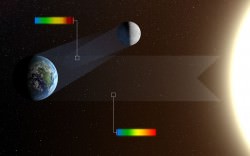[/caption]
It may seem like a silly question — of course there’s life on Earth — but what if we didn’t know that? What if we were looking at Earth from another vantage point, from another planet in another star system, perhaps? Would we be able to discern then if Earth were in fact teeming with life? All we’d have to go on would be the tiniest bit of light reflected off Earth, nearly lost in the intense glare of the Sun.
Researchers have found that the secret is knowing what kind of light to look for. And they discovered this with a little help from the Moon.

By using Earthshine — sunlight light reflected off Earth onto the Moon — astronomers with the European Southern Observatory have been able to discern variations that correlate with identifying factors of our planet as being a happy home for life.
In observations made with ESO’s Very Large Telescope (VLT), the presence of oceans, clouds, atmospheric gases and even plants could be detected in the reflected Earthshine.
The breakthrough method was the use of spectropolarimetry, which measures polarized light reflected from Earth. Like polarized sunglasses are able to filter out reflected glare to allow you to see clearer, spectropolarimetry can focus on light reflected off a planet, allowing scientists to more clearly identify important biological signatures.
“The light from a distant exoplanet is overwhelmed by the glare of the host star, so it’s very difficult to analyze — a bit like trying to study a grain of dust beside a powerful light bulb,” said Stefano Bagnulo of the Armagh Observatory, Northern Ireland, and co-author of the study. “But the light reflected by a planet is polarized, while the light from the host star is not. So polarimetric techniques help us to pick out the faint reflected light of an exoplanet from the dazzling starlight.”
Since we have fairly reliable proof that life does in fact exist on Earth, this provides astronomers with a process and a benchmark for locating evidence of life on other distant worlds — life as we know it, anyway.
Read more on the ESO website here.
Main image credit: ESO/B. Tafreshi/TWAN (twanight.org). This research was presented in a paper, “Biosignatures as revealed by spectropolarimetry of Earthshine”, by M. Sterzik et al. to appear in the journal Nature on 1st March 2012. The team is composed of Michael F. Sterzik (ESO, Chile), Stefano Bagnulo (Armagh Observatory, Northern Ireland, UK) and Enric Palle (Instituto de Astrofisica de Canarias, Tenerife, Spain).

